10 Most Famous Rembrandt Paintings
Rembrandt van Rijn, usually known as 'Rembrandt,' was a Dutch painter who lived in the 17th century and is considered to be one of the virtually famous artists in history.
He painted with a feeling of realism that would come up to exist considered virtually synonymous with the Baroque era in which he lived and worked.
He was built-in in the Netherlands in 1606 and is widely regarded equally having played a significant office during what many historians refer to as the Dutch Gilded Age.
The Baroque fashion emerged shortly after the Renaissance, and Rembrandt took influence from some of the most prolific Italian painters who had arrived in the Netherlands only a century before.
Rembrandt painted with a strong commitment to the Christian religion, equally shown by the fact that many of his most well-known works depict scenes from well-known Biblical tales.
In addition, he is well-known for painting several different self-portraits throughout his life, all of which represented him in a very honest way, as opposed to other painters who would frequently dress-upwardly their own images of themselves in guild to seem more artistic.
Famous Rembrandt Paintings
1. The Night Sentinel
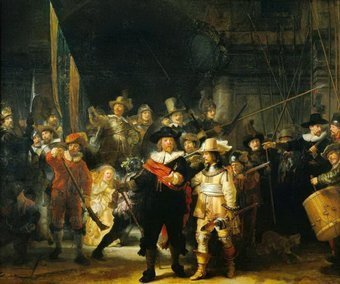
The Night Lookout man was painted in 1642 and is Rembrandt's nigh famous painting.
It is an extremely well-known piece of art for three separate reasons.
Traditionally, military machine paintings and grouping portraits tended to exist relatively static settings or scenes with piddling or no motility.
However, The Night Watch portrays the municipal militia guards, headed by Captain Banning preparing to march out from their barracks.
2d, its size is noteworthy, being a monstrous 3.63m x 4.37m and weighs a whopping 337kg(including the frame.)
Thirdly, it is famous for its dramatic use of light and shadow to direct the viewer'southward attention to the scene's major protagonists.
Rembrandt was a genuine master of low-cal; he painted The Night Spotter at the pinnacle of his career, and information technology is often regarded as his most significant work.
It is part of the collection at the Amsterdam Museum merely is prominently exhibited in the Rijksmuseum as the museum'due south nigh well-known artwork. The Nighttime Scout is one of the most iconic paintings from the Dutch Golden Age.
It has been the victim of iii major acts of vandalism and has undergone extensive restoration twice, the get-go attack did footling visible impairment due to a very thick layer of dark varnish.
The varnish was so night that it created the false impression that it showed a night scene, resulting in the film'south commonly used name.
In reality information technology was much brighter than before the varnish was removed and the painting restored.
2. The Return of the Prodigal Son
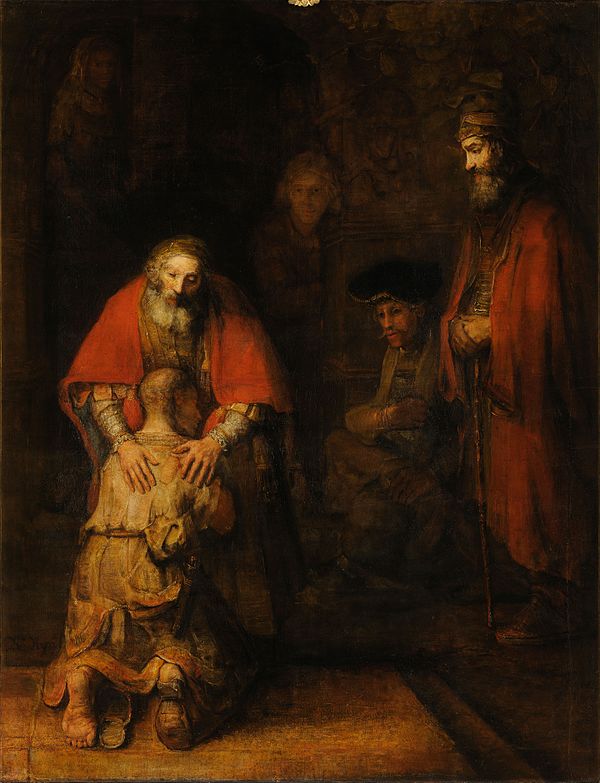
Rembrandt van Rijn was well-known for his paintings' realism features, particularly those emphasized by low-cal and gloom. His artwork, The Render of the Prodigal Son, depicts 1 of Jesus' nigh well-known parables, in which a parent and son reconcile.
Rembrandt completed the piece of work in 1669 and has been lauded by art aficionados and critics for capturing an emotional moment in the scene, also equally for the painting'south cracking degree of detail.
According to the Biblical tale, the Prodigal Son departs from his father's business firm with his early inheritance but to render years after poor and pleading to be permit back into the family's home as a servant since he no longer felt worthy of his father'south dignity.
To his surprise, his father embraces his son's return with wide arms and rejoices, whereas another son is conspicuously despised by his begetter'south attitude.
The artwork brilliantly represents the moment of the Prodigal Son'southward render to his father, every bit he kneels at his feet pleading for forgiveness. As the sibling looks on furiously, the begetter is seen soothing his kid.
3. The Anatomy Lesson of Dr. Nicolaes Tulp
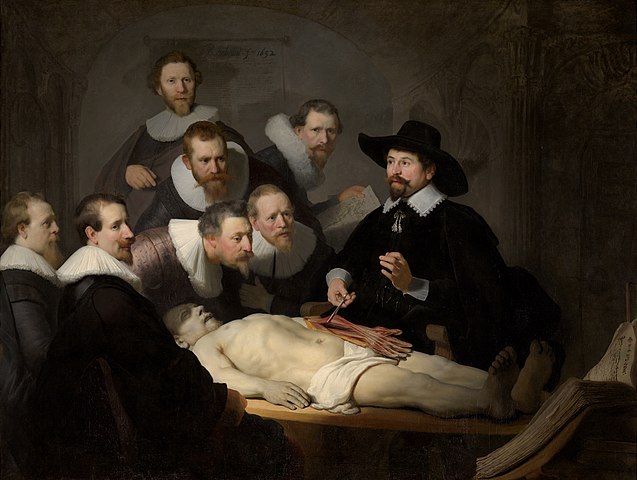
Considered to be one of Rembrandt's before masterpieces The Anatomy Lesson of Dr. Nicolaes Tulp was a committee by the Surgeon's Society.
The painting and was ane of Rembrandt'southward kickoff commissions after arriving in Amsterdam when he was merely 26 years sometime.
In the 17th century, beefcake lectures were a social event, held in lecture halls that doubled as theater, with students, colleagues, and the general public able to attend for a toll. The viewers are dressed suitably for this as they would take considered it a social gathering.
The Surgeon's Guild commissioned a portrait past a famous creative person of the era every five to ten years.
Each of the individuals in the photograph would have paid a specific amount of money to be included, and the more prominent ones (in this instance, Tulp) would take paid more, maybe fifty-fifty up to twice every bit much to exist the centre of attention.
4. The Storm on the Sea of Galilee
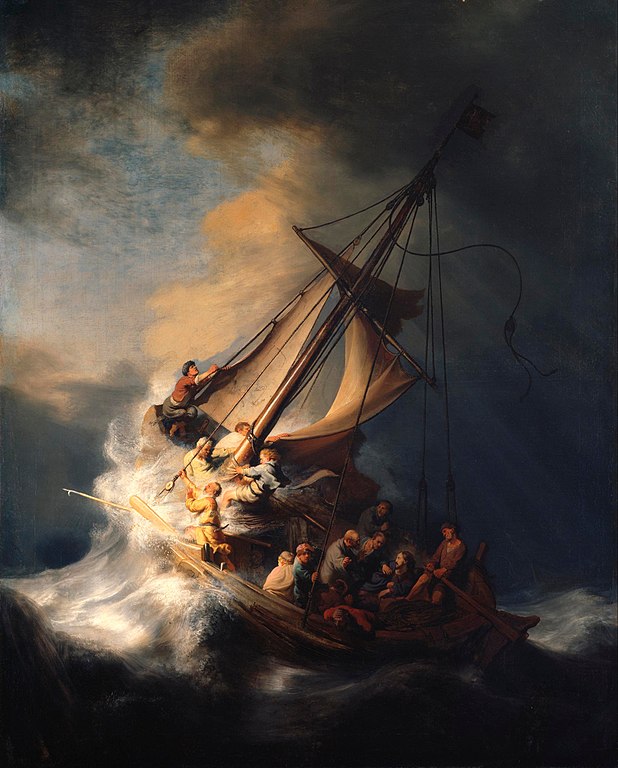
Rembrandt'southward only seascape The Storm on the Bounding main of Galilee was sadly stolen by an organized crime grouping while on display at Boston's Isabella Stewart Gardner Museum.
The picture represents the biblical tale of Jesus calming the storm on the Sea of Galilee, as told in Marking's fourth chapter.
The vertical format of the artwork depicts a close-up perspective of Christ's disciples desperately attempting to recover control of their angling gunkhole in the face up of a fierce storm.
Also Read: Famous Storm Paintings
A massive moving ridge thumps the bow and tears the sail. I of the disciples is seen puking over the side of the building. Some other is a self-portrait of the artist, facing direct out at the observer. Just Christ, every bit represented on the right, maintains his composure.
The painting is mentioned as the major piece in the Netflix Series – This Is a Robbery: The World's Greatest Art Heist which is a 2022 American documentary iv-part miniseries about the robbery of the Isabella Stewart Gardner Museum on March xviii, 1990.
5. The Jewish Bride
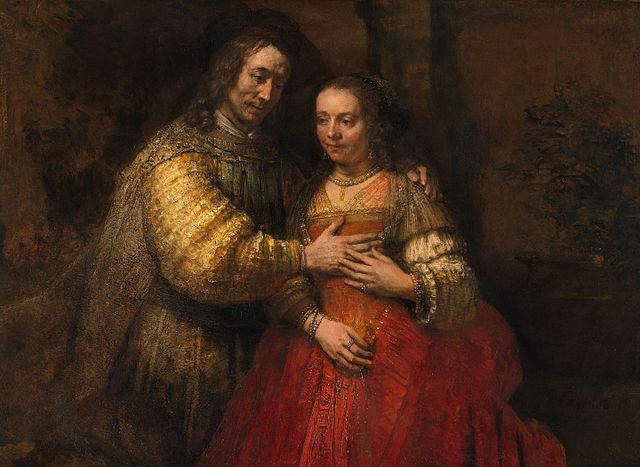
Rembrandt was renowned for his unique ability to depict persons and settings in such a way that the components on the painting appeared to come to life.
His artwork The Jewish Bride, which depicts a passionate meeting between two lovers, is besides known in the art world as Portrait of a Couple as Isaac and Rebecca.
This slice depicts a guy property a lady tenderly, one hand on her back and the other going for her chest. The woman'southward hand seems to brush confronting the homo's outstretched hand, as though she is conveying her own sentiments toward this guy. This picture depicts a couple in intense cover, just neither human nor lady looks at the other.
Vincent Van Gogh was believed to exist and then taken aback past this motion-picture show that he would willingly trade 10 years of his own life to be able to sit down and enjoy it for 2 weeks.
The painting'southward basic only profound subtleties attract a large number of art critics and aficionados, with many citing it as one of Rembrandt's finest works.
6. Syndics of the Drapers' Guild
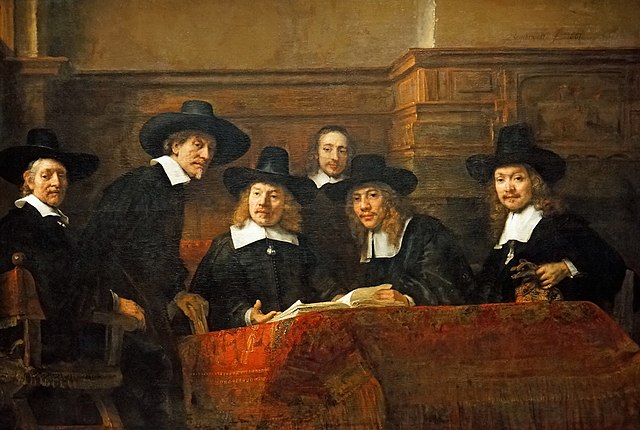
Rembrandt moved to a rented property on the Rozengracht in the 1650s after experiencing fiscal troubles. The Amsterdam élite stopped knocking on his door as often as they had earlier.
He remained popular, though, since this illustrious guild commissioned him to create a group picture. Rembrandt created an animated atmosphere past having the wardens glance upwards from their job, as though disturbed by our presence.
Described by many as his "last great collective portrait" the scene sees the men look out towards the viewer as if they were monetarily interrupted for the sitting of the portrait.
The group is portrayed sitting on a platform in front of the Drapers' Guild assembly, and they are presenting an account of the year's business organisation to the assembly – unseen past the spectator.
The men (except from Bel, who is an assistant, as shown by his lack of a cap) are drapers who were chosen to evaluate the quality of material provided for auction by weavers to lodge members.
Their i-year mandates started on Expert Friday, and they were supposed to perform inspections three times weekly throughout that fourth dimension. The Dutch term staal translates as 'sample' and refers to the textile samples that were evaluated.
seven. Danaë
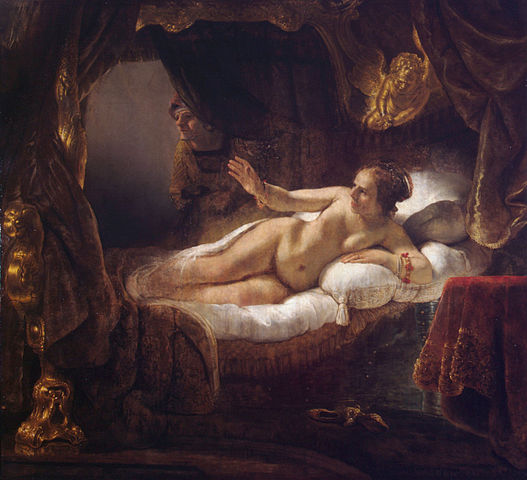
Danaë is a life-size representation of the Greek mythological heroine Dana, who is Perseus' mother. She is nearly likely shown as embracing Zeus, who impregnated her through a gold shower.
Information technology was first painted in 1636, but Rembrandt considerably revised it in the 1640s. The revision altered the placements of Danaë's head, extended arm, and legs, among other things.
Although Rembrandt'southward married woman Saskia was originally the model, he eventually replaced her face with that of his lover Geertje Dircx.
On June 15, 1985, a Soviet Lithuanian assaulted Rembrandt's artwork, hurling sulfuric acid at information technology and cutting it twice with his pocketknife. The whole middle section of the limerick was transformed into a patchwork of dots and splashes. Danaë's face and hair, besides as her right arm and legs, sustained the about damage.
The restoration procedure started the aforementioned day. Afterward consulting with scientists, art restorers started to launder the painting's surface with water in an attempt to reduce the damage further.
Between 1985 and 1997, the picture was completely restored.
eight. Belshazzar's Feast
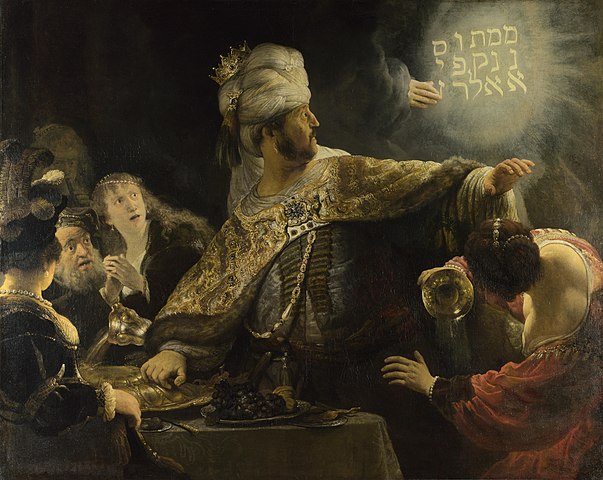
Belshazzar's Feast is a pregnant painting by Rembrandt, and information technology represents his desire to plant himself as a painter of huge, baroque historical paintings in the manner of his predecessors in the genre.
Although the verbal date of the picture is uncertain, the majority of sources place information technology between 1635 and 1638.
The National Gallery in London is where it is currently on brandish.
Since 1736, the picture had been in the hands of the Earl of Derby, who has kept it at Knowsley Hall. The painting, on the other mitt, was hardly recognized outside of England, and it was not regarded as a masterpiece.
It merely gained in popularity when the National Gallery purchased information technology in 1964, and information technology has been utilized several times as an illustration for commercial items, such every bit tape covers, in the decades that accept followed.
When Rembrandt'due south historical paintings were revalued in the 2nd part of the twentieth century, this painting along with several others have gained considerable importance equally part of Rembrandt'southward body of work.
ix. The Artist in his Studio
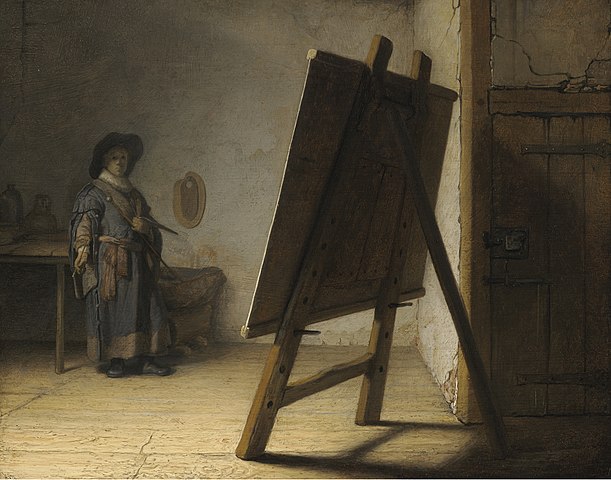
Rembrandt painted approximately 100 cocky-portraits over the form of his life, and The Artist in His Studio is unquestionably one of the most intimate works of art that he ever produced.
Information technology depicts the creative person working in a small, bare-basic studio with only the most rudimentary resources at his disposal. A big canvas is seen in the front, and it looks similar the artist has taken a step back from information technology in club to observe it from a altitude.
The grandeur of the canvas and easel in the scene is practically in direct dissimilarity to the size of The Creative person in His Studio itself.
When compared to some of his larger works, this piece is tiny, measuring just 24.viii x 31.7cm (9 3/4 x 12 1/2in) in size.
Information technology is currently be located in the Museum of Fine Arts in Boston.
10. Bathsheba at Her Bath
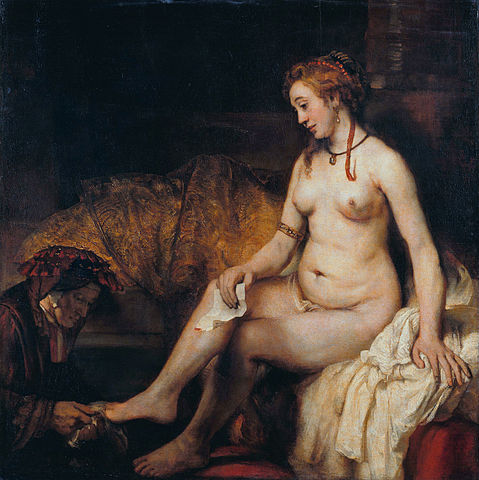
Bathsheba is a biblical character who is the wife of Uriah, a military figure who was then missing from the scene. While Uriah was out fighting in a battle, King David came across Bathsheba bathing, and upon viewing her, he fell caput over heels in beloved with her and physically dominated her.
The king sends Bathsheba's husband into war, where he is murdered, in guild to embrace upwards his indiscretion and Bathsheba's pregnancy. Every bit a outcome of her transformation, she married David and ultimately became the mother of King Solomon, who was considered to be i of the greatest monarchs of ancient history.
While previous painters have depicted the scenario of David spying on Bathsheba, Rembrandt's portrayal is distinguished past its tight visual focus and sensual vibrancy, which are achieved using wide, thick brushstrokes and brilliant colors.
Dr. Louis La Caze gave 583 pieces of art to the Louvre in 1869, and this painting is one of the finest. The canvas is referred to be "Rembrandt's finest moving-picture show of a woman." It has been hailed as "ane of the great masterpieces of western art" for its understanding of Bathsheba's moral quandary, which she faces throughout the moving picture.
Source: https://www.artst.org/rembrandt-paintings/
0 Response to "10 Most Famous Rembrandt Paintings"
Post a Comment